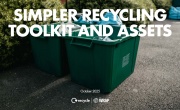Defining standards for paper and board
Dimitra Rappou, Director of Recycling at the Confederation of Paper Industries (CPI), outlines the opportunities to further extend the sustainability of fibre products
This year is the 150th anniversary of the founding of the original UK trade association for the paper sector. As the UK moves towards a circular economy, fibre-based products are growing in popularity and as public awareness has grown, the momentum toward fibre-based packaging products also increases. Paper and card packaging products rank the highest with UK consumers for sustainability attributes, including ‘better for the environment’ (69 per cent) and ‘easier to recycle’ (61 per cent), according to a European packaging preferences study commissioned by Two Sides.
 At the end of the first half of 2022, as markets gradually return to pre-pandemic levels of demand, the consumption of papers and board remained broadly stable. We were pleased to see the Printings & Writings sector continuing to recover with a growth of 6.5 per cent. The Tissue sector also increased by 7.1 per cent. But as the UK appears to be moving into recession, demand for Corrugated Case Materials and ‘Other Papers and Board’ has declined, by nine per cent and seven per cent respectively. Throughout 2022 there was modest growth in export volumes of Recovered Paper, with an increase in demand by European countries. Imports have increased by around 11 per cent, but remain a small part of the overall picture.
At the end of the first half of 2022, as markets gradually return to pre-pandemic levels of demand, the consumption of papers and board remained broadly stable. We were pleased to see the Printings & Writings sector continuing to recover with a growth of 6.5 per cent. The Tissue sector also increased by 7.1 per cent. But as the UK appears to be moving into recession, demand for Corrugated Case Materials and ‘Other Papers and Board’ has declined, by nine per cent and seven per cent respectively. Throughout 2022 there was modest growth in export volumes of Recovered Paper, with an increase in demand by European countries. Imports have increased by around 11 per cent, but remain a small part of the overall picture.
Over the last decade, the fibre feedstock in the UK remained largely unchanged with a current ratio between primary and secondary fibre of 27/73. Yet, the composition of secondary fibres used in UK paper mills has experienced significant changes. Today, Mixed Papers make up 20 per cent of secondary fibres in comparison to six per cent a decade ago, whilst the decline in the circulation of newspapers and magazines saw a drop for News and PAMs from 40 per cent to 20 per cent. These changes have been influenced by a combination of macroeconomic factors as well as changes in consumer habits. Demand for corrugated has increased due to the growth of online purchasing during the Covid lockdowns and e-commerce demand is now accounting for about 15 per cent of corrugated output. At the same time, working from home has reduced the availability of recycled white grades.
In 2022, the UK’s recycling rate for paper and card is expected to be over 70 per cent, higher than any other material, making fibre-based products the most sustainable choice. Whilst the industry is expecting more information on the reform of the Resources and Waste Strategy, the Government has already announced a target rate of 89 per cent for paper and card recycling by 2030.
 This article was taken from Issue 104
This article was taken from Issue 104The Confederation of Paper Industries (CPI) welcomes this ambitious target, although the challenge of increasing the quality of recyclate entering the waste stream should not be overlooked. For the 89 per cent target to be realistic and achievable, it needs to be supported by effective and efficient collection systems. Unless source-separated recycling collection systems are employed to ensure a high-quality output, the issue of contamination will undermine recycling efforts.
Throughout 2022, CPI has taken a leading role in defining standards for the paper sector and launched two key pieces of work. The revised Design for Recyclability Guidelines, an initiative that motivates sustainable design; and Papercycle, a fully-automated tool that determines whether fibre-based packaging formats are recyclable in the UK, and, if so, which types of mills can reprocess them. Papercycle not only provides recyclability certification services for finished packaging products but also strives to shape future packaging design by offering a product development service for semi-finished or updated products.
No doubt the paper industry has intensified its efforts to increase the quality, range and quantity of paper for recycling, whilst improving the recyclability of the more challenging materials. However, unless our efforts are underpinned by a robust regulatory regime, we risk missing a once-in-a-lifetime opportunity. We look forward to working with the Government, the supply chain, and the wider waste industry as the reforms unfold.






